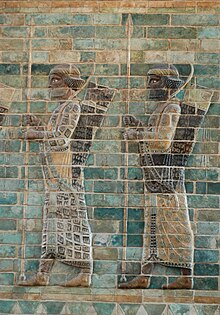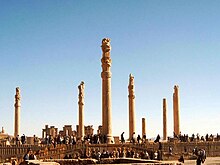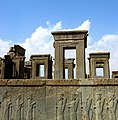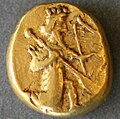Achaemenid Empire
| |||||||||||||||||||||||||||||||||||||||||||||
| History of Iran see also Kings of Persia · Timeline of Iran
|
The Persian Empire was the largest empire by geographical extent in ancient times; at the height of its power, the empire encompassed approximately 8 million km2.[1] The empire was forged by Cyrus the Great, and spanned three continents: Asia, Africa and Europe. At its greatest extent, the empire included the modern territories of Iran, Afghanistan, Pakistan, parts of Central Asia, Asia Minor, Thrace and Macedonia, much of the Black Sea coastal regions, Iraq, northern Saudi Arabia, Jordan, Israel, Lebanon, Syria, and all significant population centers of ancient Egypt as far west as Libya. It is noted in western history as the foe of the Greek city states during the Greco-Persian Wars, for emancipation of slaves including the Jews from their Babylonian captivity, and for instituting the usage of official languages throughout its territories. The empire had a centralised, bureaucratic administration under the Emperor and a permanent large army and civil service, inspiring similar developments in later empires.[2]
The Achaemenid Persian empire was invaded by Alexander III of Macedon, after which it collapsed and disintegrated in 330 BC into what later became the Ptolemaic Kingdom and Seleucid Empire, in addition to other minor territories which gained independence at that time. Iranian rule was re-established in the region starting from the rise of Arsacids in middle of 3rd century BCE.
Contents[show] |
[edit] History
[edit] Origins
Rule by the Achaemenid empire over the Iranian people started by an extension of the Achaemenid dynasty who expanded their earlier ruling clan over the Iranians going, possibly, back to the 9th century BCE. The eponym of this dynasty was Achaemenes (Old Persian: Haxāmaniš, a bahuvrihi compound translating to "having a friend's mind").[3] Achaemenes even if he was a historical personage, may have built the state Parsumash. Teispes (Cišpi) who was the first known person of this family to take the title King of Anšān after seizing the city of Anšān from the Elamites and enlarging his kingdom to include Persis.[2] According to a sentence of Xerxes I quoted by Herodotus, among the ancestors of Xerxes I, there were two persons with the name Teispes.
- "Without thy aid I will accomplish all of which I spake. For let me not be thought the child of Darius, the son of Hystaspes, the son of Arsames, the son of Ariaramnes, the son of Teispes, the son of Cyrus, the son of Cambyses, the son of Teispes, the son of Achaemenes, if I take not vengeance on the Athenians."[4]
- "King Darius says: Eight of my dynasty were kings before me; I am the ninth. Nine in succession we have been kings."[5]
- Teispes king of Anshan son of Achaemenes died c.640 BCE
- Cyrus I king of Anshan son of Teispes c.640- c.580 BCE
- Cambyses I king of Anshan son of Cyrus I c.580-559 BCE
- Cyrus II king of Anshan son of Cambyses I 559-550 then the great king of Persia from 550 BCE
- Ariaramnes king of Persis son of Teispes
- Arsames king of Persis son of Ariaramnes. He was still alive c.520 BCE.
- Teispes (I) king of Parsuash son of Achaemenes c.710- c.685 BCE
- Cambyses (I) king of Parsuash son of Teispes (I) c.685- c.660 BCE
- Cyrus (I) king of Parsuash son of Cambyses (I) c.660- c.635 BCE. We can identify him as Cyrus the king of parsuash who sent his son Arukku to the Assyrian court.
- Teispes (II) king of Anshan son of Cyrus (I) c.635- c.610 BCE
- Cyrus (II) king of Anshan son of Teispes (II) c.610- c.585 BCE
- Cambyses (II) king of Anshan son of Cyrus (II) c.585- 559 BCE
- Cyrus (III) king of Anshan 559-550 BCE & the Great king 550-530 BCE
The early Teispid rulers of Achaemenids, consistently identified themselves with the indigenous name of Elamite highlands, Anshanite. Furthermore, there is no mention of Achaemenes in genealogy of Teispids, in Cyrus Cylender.[6] According to Cyrus Cylinder[7] and other inscriptions, Teispes had a son called Cyrus succeeding his father as "King of Anshan".
There are no arguments[8] in favor of the previously held view that the kingdom of Teispes may have been divided between Cyrus and his brother Ariaramnes (Ariyāramna, 'Having the Iranians at Peace'),[9] who were succeeded by their respective sons Cambyses I of Anshan (Kambūjiya, "the Elder"), and Arsames (Aršāma "Having a Hero's Might") of Persis, thus forming two branches of the Achaemenid royal house.
[edit] Formation and expansion of the empire
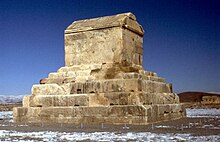

In 559 BCE, Cambyses I the Elder was succeeded as king of Anšān by his son Cyrus II the Great, who also succeeded the still-living Arsames as King of Persia, thus reuniting the two realms. Cyrus is considered to be the first true king of the Persian empire, as his predecessors were subservient to Media. Cyrus II conquered Media, Lydia, and Babylon. Cyrus was politically shrewd, modeling himself as the "savior" of conquered nations. To reinforce this image, he instituted policies of religious freedom, and restored temples and other infrastructure in the newly acquired cities. (Most notably the Jews of Babylon, as recorded in the Cyrus Cylinder and the Tanakh).
His immediate successors were less successful. Cyrus' son Cambyses II conquered Egypt, but died in July 522 BCE as the result of either accident or suicide, during a revolt led by a sacerdotal clan that had lost its power following Cyrus' conquest of Media. These priests, whom Herodotus called Magi, usurped the throne for one of their own, Gaumata, who then pretended to be Cambyses II's younger brother Smerdis (Pers. Bardiya), who had been assassinated some three years earlier. Owing to the despotic rule of Cambyses and his long absence in Egypt, "the whole people, Perses, Medes and all the other nations," acknowledged the usurper, especially as he granted a remission of taxes for three years (Herodotus iii. 68).
The claim that Gaumata had impersonated Smerdis, is derived from Darius. Historians are divided over the possibility that the story of the impostor was invented by Darius as justification for his coup.[11][12] Darius made a similar claim when he later captured Babylon, announcing that the Babylonian king was not, in fact, Nebuchadnezzar III, but an impostor named Nidintu-bel.[13]
According to the Behistun Inscription, pseudo-Smerdis ruled for seven months before being overthrown in 522 BCE by a member of a lateral branch of the Achaemenid family, Darius I (Old Persian Dāryavuš "Who Holds Firm the Good", also known as Darayarahush or Darius the Great). The Magi, though persecuted, continued to exist, and a year following the death of the first pseudo-Smerdis (Gaumata), saw a second pseudo-Smerdis (named Vahyazdāta) attempt a coup. The coup, though initially successful, failed.
Herodotus writes[14] that the native leadership debated the best form of government for the Empire. It was agreed that an oligarchy would divide them against one another, and democracy would bring about mob rule resulting in a charismatic leader resuming the monarchy. Therefore, they decided a new monarch was in order, particularly since they were in a position to choose him. Darius I was chosen monarch from among the leaders. He was cousin to Cambyses II and Smerdis, claiming Ariaramnes as his ancestor.
The Achaemenids thereafter consolidated areas firmly under their control. It was Cyrus the Great and Darius the Great who, by sound and farsighted administrative planning, brilliant military maneuvering, and a humanistic world view, established the greatness of the Achaemenids and, in less than thirty years, raised them from an obscure tribe to a world power. It was during the reign of Darius I that Persepolis was built (518–516 BC) and which would serve as capital for several generations of Achaemenid kings. Ecbatana (Hagmatāna "City of Gatherings", modern Hamadan) in Media was greatly expanded during this period and served as the summer capital.
Darius I attacked the Greek mainland, which had supported rebellious Greek colonies under his aegis; but as a result of his defeat at the Battle of Marathon, he was forced to pull the limits of his empire back to Asia Minor.
[edit] Greco-Persian Wars
The Ionian Revolt in 499 BCE, and associated revolts in Aeolis, Doris, Cyprus and Caria, were military rebellions by several regions of Asia Minor against Persian rule, lasting from 499 to 493 BCE. At the heart of the rebellion was the dissatisfaction of the Greek cities of Asia Minor with the tyrants appointed by Persia to rule them, along with the individual actions of two Milesian tyrants, Histiaeus and Aristagoras. In 499 BCE the then tyrant of Miletus, Aristagoras, launched a joint expedition with the Persian satrap Artaphernes to conquer Naxos, in an attempt to bolster his position in Miletus (both financially and in terms of prestige). The mission was a debacle, and sensing his imminent removal as tyrant, Aristagoras chose to incite the whole of Ionia into rebellion against the Persian king Darius the Great.
The Persians continued to reduce the cities along the west coast that still held out against them, before finally imposing a peace settlement in 493 BC on Ionia that was generally considered to be both just and fair. The Ionian Revolt constituted the first major conflict between Greece and the Achaemenid Empire, and as such represents the first phase of the Greco-Persian Wars. Asia Minor had been brought back into the Persian fold, but Darius had vowed to punish Athens and Eretria for their support for the revolt.[67] [The Athenian support was particularly troubling to Darius since he had come to their aid during their conflict with Sparta]. Moreover, seeing that the political situation in Greece posed a continued threat to the stability of his Empire, he decided to embark on the conquest of all Greece. However, the Persian forces were defeated at the Battle of Marathon. Darius would die before launching a formal invasion of Greece.
Xerxes I (485–465 BC, Old Persian Xšayārša "Hero Among Kings"), son of Darius I, vowed to complete the job. He organized a massive invasion aiming to conquer Greece. His army entered Greece from the north, meeting little or no resistance through Macedonia and Thessaly, but was delayed by a small Greek force for three days at Thermopylae. A simultaneous naval battle at Artemisium was tactically indecisive as large storms destroyed ships from both sides. The battle was stopped prematurely when the Greeks received news of the defeat at Thermopylae and retreated. The battle was a strategic victory for the Persians, giving them uncontested control of Artemisium and Aegean Sea.
Following his victory at the Battle of Thermopylae, Xerxes sacked the evacuated city of Athens and prepared to meet the Greeks at the strategic Isthmus of Corinth and the Saronic Gulf. In 480 BCE the Greeks won a decisive victory at the Battle of Salamis and forced Xerxes to retire to Sardis. The army which he left in Greece under Mardonius retook Athens but was eventually destroyed in 479 BCE at the Battle of Plataea. The final defeat of the Persians at Mycale encouraged the Greek cities of Asia to revolt, and marked the end of Persian expansion into Europe.
[edit] The cultural phase


Artaxerxes I died in Susa, and his body was brought to Persepolis for internment in the tomb of his forebears. Artaxerxes I was immediately succeeded by his eldest son Xerxes II, who was however assassinated by one of his half-brothers a few weeks later. Darius II rallied support for himself and marched eastwards, executing the assassin and was crowned in his stead.
From 412 Darius II (423–404 BC), at the insistence of the able Tissaphernes, gave support first to Athens, then to Sparta, but in 407 BCE, Darius' son Cyrus the Younger was appointed to replace Tissaphernes and aid was given entirely to Sparta which finally defeated Athens in 404 BCE. In the same year, Darius fell ill and died in Babylon. At his deathbed, his Babylonian wife Parysatis pleaded with Darius to have her second eldest son Cyrus (the Younger) crowned, but Darius refused.
Darius was then succeeded by his eldest son Artaxerxes II Memnon. Plutarch relates (probably on the authority of Ctesias) that the displaced Tissaphernes came to the new king on his coronation day to warn him that his younger brother Cyrus (the Younger) was preparing to assassinate him during the ceremony. Artaxerxes had Cyrus arrested and would have had him executed if their mother Parysatis had not intervened. Cyrus was then sent back as Satrap of Lydia, where he prepared an armed rebellion. Cyrus and Artaxerxes met in the Battle of Cunaxa in 401 BCE, where Cyrus was killed.
Artaxerxes II (404–358 BCE), was the longest reigning of the Achaemenid kings and it was during this 45-year period of relative peace and stability that many of the monuments of the era were constructed. Artaxerxes moved the capital back to Persepolis, which he greatly extended. Also the summer capital at Ecbatana was lavishly extended with gilded columns and roof tiles of silver and copper (Polybius, 10.27.12). The extraordinary innovation of the Zoroastrian shrine cults can also be dated to his reign, and it was probably during this period that Zoroastrianism was disseminated throughout Asia Minor and the Levant, from Armenia. The temples, though serving a religious purpose, were however not a purely selfless act: they also served as an important source of income. From the Babylonian kings, the Achaemenids had taken over the concept of a mandatory temple tax, a one-tenth tithe which all inhabitants paid to the temple nearest to their land or other source of income (Dandamaev & Lukonin, 1989:361–362). A share of this income called the quppu ša šarri, "kings chest"—an ingenious institution originally introduced by Nabonidus—was then turned over to the ruler. In retrospect, Artaxerxes is generally regarded as an amiable man who lacked the moral fibre to be a really successful ruler. However, six centuries later Ardeshir I, founder of the second Persian Empire, would consider himself Artaxerxes' successor, a grand testimony to the importance of Artaxerxes to the Persian psyche.
[edit] Fall of the empire
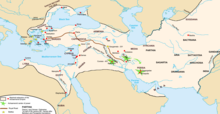

Artaxerxes III was succeeded by Artaxerxes IV Arses, who before he could act was also poisoned by Bagoas. Bagoas is further said to have killed not only all Arses' children, but many of the other princes of the land. Bagoas then placed Darius III (336–330 BCE), a nephew of Artaxerxes IV, on the throne.
Darius III, previously Satrap of Armenia, personally forced Bagoas to swallow poison. In 334 BCE, when Darius was just succeeding in subduing Egypt again, Alexander and his battle-hardened troops invaded Asia Minor.
At two different times, the Achaemenids ruled Egypt although the Egyptians twice regained temporary independence from Persia. After the practice of Manetho, Egyptian historians refer to the periods in Egypt when the Achaemenid dynasty ruled as the twenty-seventh dynasty of Egypt, 525–404 BC, until the death of Darius II, and the thirty-first dynasty of Egypt, 343–332 BCE, which began after Nectanebo II was defeated by the Persian king Artaxerxes III.
Alexander defeated the Persian armies at Granicus (334 BCE), followed by Issus (332 BCE), and last at Gaugamela (331 BCE).
Afterwards, he marched on Susa and Persepolis which surrendered in early 330 BCE. From Persepolis, Alexander headed north to Pasargadae where he treated the tomb of Cyrus II with respect. From there he headed to Ecbatana, where Darius III had sought refuge.
Darius III was taken prisoner by Bessus, his Bactrian satrap and kinsman. As Alexander approached, Bessus had his men murder Darius and then declared himself Darius' successor, as Artaxerxes V, before retreating into Central Asia leaving Darius' body in the road to delay Alexander, who brought it to Persepolis for an honorable funeral.
The Achaemenid Empire was succeeded by the Seleucid Empire, ruled by the generals of Alexander and their descendants. They in turn would be succeeded by the Parthian Empire.
Istakhr, one of the vassal kingdoms of the Parthian Empire, would be overthrown by Papak, a priest of the temple there. Papak's son, Ardašir I, who named himself in remembrance of Artaxerxes II, revolted against the Parthians, defeated them and established the Sassanid Empire.
[edit] Government
| |||


Cyrus created an organized army including the Immortals unit, consisting of 10,000 highly trained soldiers.[20] Cyrus also formed an innovative postal system throughout the empire, based on several relay stations called Chapar Khaneh.[21]
Darius the Great moved the capital from Pasargadae to Persepolis,[22] he revolutionized the economy by placing it on a silver and gold coinage system also introducing a regulated and sustainable Tax system that was precisely tailored to each satrapy, based on their supposed productivity and their economic potential. For instance, Babylon was assessed for the highest amount and for a startling mixture of commodities - 1000 silver talents, four months supply of food for the army. India clearly, was already fabled for its gold; the province was to supply gold dust equal in value to the very large amount of 4680 silver talents. Egypt was known for the wealth of its crops; it was to be the granary of the Persian Empire (as later of Rome's) and was required to provide 120,000 measures of grain in addition to 700 talents of silver. This was exclusively a tax levied on subject peoples.[23] Other accomplishments of Darius' reign included codification of the data, a universal legal system, and construction of a new capital at Persepolis.
Under the Achaemenids, the trade was extensive and there was an efficient infrastructure that facilitated the exchange of commodities in the far reaches of the empire. Tariffs on trade were one of the empire's main sources of revenue, along with agriculture and tribute.[23][24]
The satrapies were linked by a 2,500-kilometer highway, the most impressive stretch being the Royal Road from Susa to Sardis, built by command of Darius I. The relays of mounted couriers could reach the remotest of areas in fifteen days. Despite the relative local independence afforded by the satrapy system, royal inspectors, the "eyes and ears of the king", toured the empire and reported on local conditions. The king also maintained a personal bodyguard of the elite 10,000 Immortals when not at war.
The practice of slavery in Achaemenid Persia was generally banned, although there is evidence that conquered and/or rebellious armies were sold into captivity.[25] Zoroastrianism, the de facto religion of the empire, explicitly forbids slavery,[26] and the kings of Achaemenid Persia, especially the founder Cyrus the Great, followed this ban to varying degrees, as evidenced by the freeing of the Jews at Babylon, and the construction of Persepolis by paid workers.
The vexilloid of the Achaemenid Empire was a gold falcon on a field of crimson.[27][28]
Georg W. F. Hegel in his work "The Philosophy of History" introduces the Persian Empire as the first empire that passed away and its people as the first historical people in history. According to his account;[29]
- "The Persian Empire is an Empire in the modern sense – like that which existed in Germany, and the great imperial realm under the sway of Napoleon; for we find it consisting of a number of states, which are indeed dependant, but which have retained their own individuality, their manners, and laws. The general enactments, binding upon all, did not infringe upon their political and social idiosyncrasies, but even protected and maintained them; so that each of the nations that constitute the whole, had its own form of constitution. As light illuminates everything – imparting to each object a peculiar vitality – so the Persian Empire extends over a multitude of nations, and leaves to each one its particular character. Some have even kings of their own; each one its distinct language, arms, way of life and customs. All this diversity coexists harmoniously under the impartial dominion of Light... a combination of peoples – leaving each of them free. Thereby, a stop is put to that barbarism and ferocity with which the nations had been wont to carry on their destructive feuds.”
Philip Groisser the American historian in his book, the "World History" notes:[31] “The Greeks and the Romans later copied the best features of the Persian Method of Governing the Empire.”
[edit] Culture
Herodotus, in his mid-5th century BCE account[citation needed] of Iranian residents of the Pontus, reports that Iranian youths, from their fifth year to their twentieth year, were instructed in three things - to ride a horse, to draw a bow, and to speak the Truth.He further notes[citation needed] that:
- the most disgraceful thing in the world [the Perses] think, is to tell a lie; the next worst, to owe a debt: because, among other reasons, the debtor is obliged to tell lies.
- I was not a lie-follower, I was not a doer of wrong ... According to righteousness I conducted myself. Neither to the weak or to the powerful did I do wrong. The man who cooperated with my house, him I rewarded well; who so did injury, him I punished well.
- I smote them and took prisoner nine kings. One was Gaumata by name, a Magian; he lied; thus he said: I am Smerdis, the son of Cyrus...One, Acina by name, an Elamite; he lied; thus he said: I am king in Elam... One, Nidintu-Bel by name, a Babylonian; he lied; thus he said: I am Nebuchadnezzar, the son of Nabonidus. King Darius then tells us, The Lie made them rebellious, so that these men deceived the people.[35]
- Thou who shalt be king hereafter, protect yourself vigorously from the Lie; the man who shall be a lie-follower, him do thou punish well, if thus thou shall think. May my country be secure!
[edit] Languages

Following the conquest of Mesopotamia, the Aramaic language (as used in that territory) was adopted as a "vehicle for written communication between the different regions of the vast empire with its different peoples and languages. The use of a single official language, which modern scholarship has dubbed Official Aramaic or Imperial Aramaic, can be assumed to have greatly contributed to the astonishing success of the Achaemenids in holding their far-flung empire together for as long as they did."[36] In 1955, Richard Frye questioned the classification of Imperial Aramaic as an "official language", noting that no surviving edict expressly and unambiguously accorded that status to any particular language.[37] Frye reclassifies Imperial Aramaic as the "lingua franca" of the Achaemenid territories, suggesting then that the Achaemenid-era use of Aramaic was more pervasive than generally thought. Many centuries after the fall of the empire, Aramaic script and - as ideograms - Aramaic vocabulary would survive as the essential characteristics of the Pahlavi writing system.[38]
Although Old Persian also appears on some seals and art objects, that language is attested primarily in the Achaemenid inscriptions of Western Iran, suggesting then that Old Persian was the common language of that region. However, by the reign of Artaxerxes II, the grammar and orthography of the inscriptions was so "far from perfect"[39] that it has been suggested that the scribes who composed those texts had already largely forgotten the language, and had to rely on older inscriptions, which they to a great extent reproduced verbatim.[40]
[edit] Customs
Herodotus mentions that the Persians were given to great birthday feasts (Herodotus, Histories 8), which would be followed by many desserts, a treat which they reproached the Greeks for omitting from their meals. He also observed that the Persians drank wine in large quantities and used it even for counsel, deliberating on important affairs when drunk, and deciding the next day, when sober, whether to act on the decision or set it aside.[edit] Religion
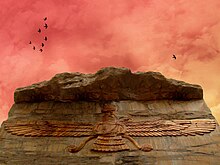
Under the patronage of the Achaemenid kings, and by the fifth century BCE as the de-facto religion of the state, Zoroastrianism would reach all corners of the empire. The Bible claims that Cyrus the Great allowed the Jews to return to their homeland after centuries of captivity by the Assyrian and Babylonian empires.
During the reign of Artaxerxes I and Darius II, Herodotus wrote "[the Perses] have no images of the gods, no temples nor altars, and consider the use of them a sign of folly. This comes, I think, from their not believing the gods to have the same nature with men, as the Greeks imagine." He claims the Persians offer sacrifice to: "the sun and moon, to the earth, to fire, to water, and to the winds. These are the only gods whose worship has come down to them from ancient times. At a later period they began the worship of Urania, which they borrowed from the Arabians and Assyrians. Mylitta is the name by which the Assyrians know this goddess, whom the Arabians call Alitta, and the Persians Anahita." (The original name here is Mithra, which has since been explained to be a confusion of Anahita with Mithra, understandable since they were commonly worshipped together in one temple).
From the Babylonian scholar-priest Berosus, who—although writing over seventy years after the reign of Artaxerxes II Mnemon—records that the emperor had been the first to make cult statues of divinities and have them placed in temples in many of the major cities of the empire (Berosus, III.65). Berosus also substantiates Herodotus when he says the Persians knew of no images of gods until Artaxerxes II erected those images. On the means of sacrifice, Herodotus adds "they raise no altar, light no fire, pour no libations." This sentence has been interpreted to identify a critical (but later) accretion to Zoroastrianism. An altar with a wood-burning fire and the Yasna service at which libations are poured are all clearly identifiable with modern Zoroastrianism, but apparently, were practices that had not yet developed in the mid-fifth century. Boyce also assigns that development to the reign of Artaxerxes II (fourth century BCE), as an orthodox response to the innovation of the shrine cults.
Herodotus also observed that "no prayer or offering can be made without a magus present" but this should not be confused with what is today understood by the term magus, that is a magupat (modern Persian: mobed), a Zoroastrian priest. Nor does Herodotus' description of the term as one of the tribes or castes of the Medes necessarily imply that these magi were Medians. They simply were a hereditary priesthood to be found all over Western Iran and although (originally) not associated with any one specific religion, they were traditionally responsible for all ritual and religious services. Although the unequivocal identification of the magus with Zoroastrianism came later (Sassanid era, third–seventh century CE), it is from Herodotus' magus of the mid-fifth century that Zoroastrianism was subject to doctrinal modifications that are today considered to be revocations of the original teachings of the prophet. Also, many of the ritual practices described in the Avesta's Vendidad (such as exposure of the dead) were already practiced by the magu of Herodotus ' time.
[edit] Art and architecture

Moreover, when Cyrus chose to build Pasargadae, he had a long artistic tradition behind him that probably was distinctly Iranian already and that was in many ways the equal of any. The columned hall in architecture can now be seen as belonging to an architectural tradition on the Iranian Plateau that extended back through the Median period. The rich Achaemenid gold work, which inscriptions suggest may have been a specialty of the Medes, was in the tradition of the delicate metalwork found in Iron Age II times at Hasanlu and still earlier at Marlik.
This artistic style is particularly evident at Persepolis: with its carefully proportioned and well-organized ground plan, rich architectural ornament, and magnificent decorative reliefs, the palace there is one of the great artistic legacies of the ancient world. In its art and architecture, Persepolis celebrates the king and the office of the monarch and reflected Darius' perception of himself as the leader of a conglomerate people to whom he had given a new and single identity. The Achaemenids took the art forms and the cultural and religious traditions of many of the ancient Middle Eastern peoples and combined them into a single form.
In describing the construction of his palace at Susa, Darius records that "The cedar timber from there (a mountain by name Lebanon) was brought, the yaka timber was brought from Gandara and from Carmania. The gold was brought from Sardis and from Bactria . . . the precious stone lapis-lazuli and carnelian . . . was brought from Sogdiana. The turquoise from Chorasmia, the silver and ebony from Egypt, the ornamentation from Ionia, the ivory from Ethiopia and from Sindh (Pakistan) and from Arachosia. The stone-cutters who wrought the stone, those were Ionians and Sardians. The goldsmiths were Medes and Egyptians. The men who wrought the wood, those were Sardians and Egyptians. The men who wrought the baked brick, those were Babylonians. The men who adorned the wall, those were Medes and Egyptians."
This was imperial art on a scale the world had not seen before. Materials and artists were drawn from all corners of the empire, and thus tastes, styles, and motifs became mixed together in an eclectic art and architecture that in itself mirrored the empire and the Persian understanding of how that empire ought to function.
[edit] Achaemenid kings and rulers
[edit] Unattested
- The epigraphic evidence for these rulers cannot be confirmed and are often considered to have been invented by Darius I
- Ariaramnes of Persia, son of Teispes and co-ruler with Cyrus I
- Arsames of Persia, son of Ariaramnes and co-ruler with Cambyses I
[edit] Attested
-
- Teispes of Anshan, son of Achaemenes
- Cyrus I of Anshan, son of Teispes
- Cambyses I of Anshan, son of Cyrus I
- Cyrus II the Great, son of Cambyses I, ruled from c.550-530 BCE E(ruler of Anshan c. 559 BCE – conquered Media 550 BCE)
- Cambyses II, son of Cyrus the Great, ruled 529-522 BCE
- Smerdis (Bardiya), alleged son of Cyrus the Great, ruled 522 BCE (Possibly an usurper)
- Darius I the Great, brother-in-law of Smerdis and grandson of Arsames, ruled 521-486 BCE
- Xerxes I the Great, son of Darius I, ruled 485-465 BCE
- Artaxerxes I Longimanus, son of Xerxes I, ruled 465-424 BCE
- Xerxes II, son of Artaxerxes I, ruled 424 BCE
- Sogdianus, half-brother and rival of Xerxes II, ruled 424-423 BCE
- Darius II Nothus, half-brother and rival of Xerxes II, ruled 423-405 BCE
- Artaxerxes II Mnemon, son of Darius II, ruled 404-359 BCE (see also Xenophon)
- Artaxerxes III Ochus, son of Artaxerxes II, ruled 358-338 BCE
- Artaxerxes IV Arses, son of Artaxerxes III, ruled 338-336 BCE
- Darius III Codomannus, great-grandson of Darius II, ruled 336-330 BCE
[edit] Gallery
| | This section looks like an image gallery. Wikipedia policy discourages galleries of random images of the article subject; please improve or remove the section accordingly, moving freely licensed images to Wikimedia Commons if not already hosted there. |
| Relief of Xerxes I the Great at Persepolis in Iran. | |||
[edit] See also
- List of kings of Persia
- Purim, a Jewish festival related to the Achaemenid Empire





